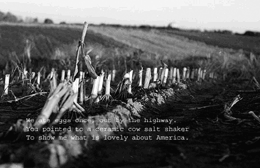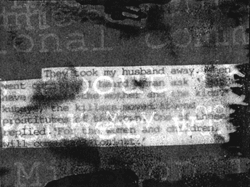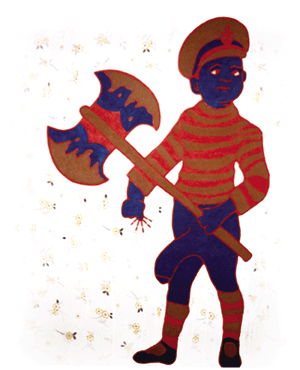
War and Work
Responses of SAIC Graduate Student Artists
By Joanne Hinkel
Two weeks ago I set out to write an article on the reaction of student artists to the attacks on New York and Washington and the ongoing war in Afghanistan. My plan was to interview people on their emotional state, to find out if anyone felt too uncomfortable to create or to proceed with their imaginative endeavors at a time clearly marked by anxiety, unease and grief. Soon enough, though, my pursuits felt cliché, useless and even trite. In my discussions with people two main responses kept coming up: A) Of course we are upset; B) But of course we must proceed with artmaking, isn't that what we do anyway?
If anyone's initial reaction to 9/11 was that it was too selfish to make art, then the subsequent reaction was that it is more selfish not to make art. It became clear that what I should do with this space is to discuss how students at SAIC are dealing with the ongoing crisis in their work, both emotionally and politically. Although many students have not had enough time or distance from these events to directly react to them in their work, many of the issues they are already confronting, and have been confronting in their art, are incredibly relevant to our present situation. The upcoming exhibit at the Student Union Art Gallery this December, 9.11, will undoubtedly communicate more on this topic.
The exploration into the critical minds and work of three graduate students that follows also serves to chart the very different reactions that we all are having - from emotional, to political, to analytical, to just unsure.
In MEMORIAL
The events of September 11 did have a direct impact on Julianne Flynn's artwork. Phone lines flooded across the country that day and proved how many people experienced the feeling of wanting to reconnect and commiserate with loved ones. That morning of phone calls affected Flynn with a feeling that she needed to get closer to the people she cares about. Shortly after the terrorist attacks, Flynn had to come up with a term project for her "Conceptual Action in Writing" course. Although she had been considering a conceptual action of retreating to a monastery to live as a Buddhist monk, Flynn realized she wanted to deal with her emotional state at the time: she decided to make a website memorializing all the people she cares about.
"The reason I chose a website is because it's a place to store memory, perhaps it's a kind of time capsule... with everything that's going on this is a way to keep my sanity, stay positive, and to reconnect with people."
For the past two months, Flynn has been interviewing friends, her parents, siblings, any and all the loved ones in her life, as well as people she meets along the way. Her questions are open ended, but the idea of the interview is to get to each person's fondest memory, the most essential experience, feeling or moment of their lives which they want to remember forever. In essence, the memory they would want to remember if they were about to die.
"The memories run the gamut," Flynn said. "I've been trying to steer away from the traumatic [memories]. Maybe that's kind of pollyannaish of me, but the memory that comes up is often a negative one... but it's not about that, it's about trying to figure out what's important to us. If you're going to break it down, if you're going to be 'stored,' what do you want to remember?"
Flynn then synthesizes the memory into an artistic representation of some kind, whether poetic, photographic, or symbolic, and then stores it in the website's memory bank. The homepage of the site will show a view of the star-studded galaxy through the perspective of the Hubble telescope. The memories will be anonymously stored in these stars. Users will not know where to click to reveal a memory among these thousands points of light, but that's precisely the point-we are each small blips on the screen of life.
Among the several texts that Flynn has collected for her memory bank, is the example above. It is a poem inspired by a memory of a college buddy, who happens to be Arab and from Tunisia:
"I definitely responded differently to the Iraqi war, through journalism and activism," Flynn added. "But this [war] definitely is [rousing] a more personal reaction, this time for me it's more about coming to terms with what life is."
A Letter to Tunisia
 We ate eggs once out by the highway,
We ate eggs once out by the highway,
you pointed to the ceramic cow salt shaker
to show me what is lovely about America.
You asked me about my hands, and maybe even touched them;
I can't remember.
Was it you that planted and pulled?
Was it your father that began coughing in the mines?
"Anything is still possible here," you said,
reaching for the salt cow.
I could taste the ocean between us.
In MEDIA
As a born New Yorker Holen Kahn, a graduate in the Film Video and New Media department, was seriously shaken by the terrorism. "I had the same reaction as most people in the first couple of weeks, I couldn't concentrate," she said. "There was both an emotional distraction and a literal distraction."
But could she still create? Did she have the same sentiments as represented by the posters that are hung up around school, asking, "How do we go on? How can we construct again?"
"Honestly, I find [those posters] really arrogant, my world didn't shift so dramatically. I found things to be scary before, it's been scary most of my life. It's emotionally draining the way the world is," she said.
 Upon entering Kahn's studio in the Michigan building, you spot a gas mask and wonder why it's there. "No," she laughed, "That was there before." Oh, she had been working with some toxic chemicals in the process of putting together an installation. The next glaring sight in her studio is more startling - it is a pile of dirt with a large shovel sticking out. These are clearly the materials needed for someone to dig a makeshift grave. This gravesite is one component in an intricate installation Kahn is working on which will juxtapose the reality of death and genocide in Rwanda with imagery related to the very bland and glossed-over media coverage of this atrocity. Upon entering Kahn's studio in the Michigan building, you spot a gas mask and wonder why it's there. "No," she laughed, "That was there before." Oh, she had been working with some toxic chemicals in the process of putting together an installation. The next glaring sight in her studio is more startling - it is a pile of dirt with a large shovel sticking out. These are clearly the materials needed for someone to dig a makeshift grave. This gravesite is one component in an intricate installation Kahn is working on which will juxtapose the reality of death and genocide in Rwanda with imagery related to the very bland and glossed-over media coverage of this atrocity.
"By using the case study of Rwanda, I'm looking at how the West relates to Africa, issues of race and racism, and colonialism. The word that I focus on most is genocide."
Kahn's installation focuses on the word genocide because the Clinton administration refused to use the word in relation to discussing the 1994 Rwandan war which entailed the slaughter of nearly a million Tutsi people by the Hutu. Many Americans, seven years later, are still unaware of the massive slaughter that took place within three months in Rwanda. Seemingly, this censorship by the Clinton administration was implemented in order to keep a public outcry in America at bay. Also in this installation, which will be on view as part of a Gallery 2 group show starting November 9, video stills from mainstream news reports are fused with alternative journalistic texts and prose conveying the reality of the genocide. These images reveal a grand distinction between what we know to be true as opposed to what we're told, and holds the public accountable for not bothering to understand these discrepancies.
"[My work] is about how empathies are constructed, and about how there is a lack of critical engagement concerning how the media and the government build those empathies," Kahn explained.
At a time of war with Afghanistan, when we are trusting the government to keep journalists updated with accurate and truthful information, these issues of censorship and media manipulation remain seriously relevant. As much as probing her viewers to ask themselves what they read and accept as truth from the media, Khan's work asks how we (the media, the government, the citizens of the "free world") decide which lives merit our attention and military reaction. In essence, how can lives in one country mean more than lives in another? Kahn is visibly shaken by the thought that 6,000 lives in New York are treasured while more than 800,000 lives in Rwanda are so easily forgotten and uses this feeling of injustice to proceed with her work.
Throughout Kahn's work, which is undoubtedly political, she is invested in a personal attempt to find some kind of truth embedded within the myth-making systems in which we live. On a lighter note we laugh as she points out that the "Letter from Canada" praising U.S. policies, which has been passed around via email since the terrorist attacks, is dated from 1973.
In MASCULINITY
 Michael Cline has long been dealing with issues of masculinity in his work. He appropriates such archetypal icons of masculinity as football players and soldiers and inserts them into the illusory world of his paintings. Using small swatches of fabric and life-size canvases Cline creates a fantasy world of football player deities and phallic gods which serves to parody the values of aggression and virulence in our society. Michael Cline has long been dealing with issues of masculinity in his work. He appropriates such archetypal icons of masculinity as football players and soldiers and inserts them into the illusory world of his paintings. Using small swatches of fabric and life-size canvases Cline creates a fantasy world of football player deities and phallic gods which serves to parody the values of aggression and virulence in our society.
"Artistically it hasn't affected me. I guess I'm not shocked. There's always this continuous cycle of civilization, there's always war then peace."
Though on the one hand Cline feels unaffected in terms of his practice, he also recognizes his artwork bears a relationship to the war whether or not he wants it to. In one painting a bubbling phallic image, almost looking like a genie erupting from a bottle, makes its way up the middle of the canvas and is flanked by football player attendant gods who are both in positions prepared to throw the ball. This mock-up world of deities demands that Americans ask themselves what they treasure about this culture.
"It's a strange time to be an artist," Cline said. "Our minds are built to get information and break it down and then react to it."
Although he's not going to stop what he does, Cline almost feels strange about being critical of our cultural values at a time when there is a popular sentiment in this country to band together and not be critical.
In a way, Cline's creations seem to be feminine recontextualizations of masculine icons. He incorporates ornate imagery and traditionally female forms of artmaking such as embroidery in his compositions. He is influenced by childhood memories of playing as a soldier and toys like G.I. Joe in terms of content, and by the work of Gustave Klimt, he said, who "was a brutal guy who made beautiful, gorgeous paintings," in terms of style.
One aspect of this war directly affects Cline's work.
"There's so much source material right now. Especially in the Chicago Tribune, almost every day they run a picture of a soldier linked with the Northern Alliance."
Cline's been tracing and redrawing these images of soldiers dwarfed by the most phallic symbol of all- a gun - and plans to use these images in future paintings.
The idea that I can't help but think about concerning Cline's paintings is that if women were ruling the world, maybe it would be more cooperative, more about understanding rather than proving, more about peace. In this case, maybe there would never be violence, there would never be war.
|

